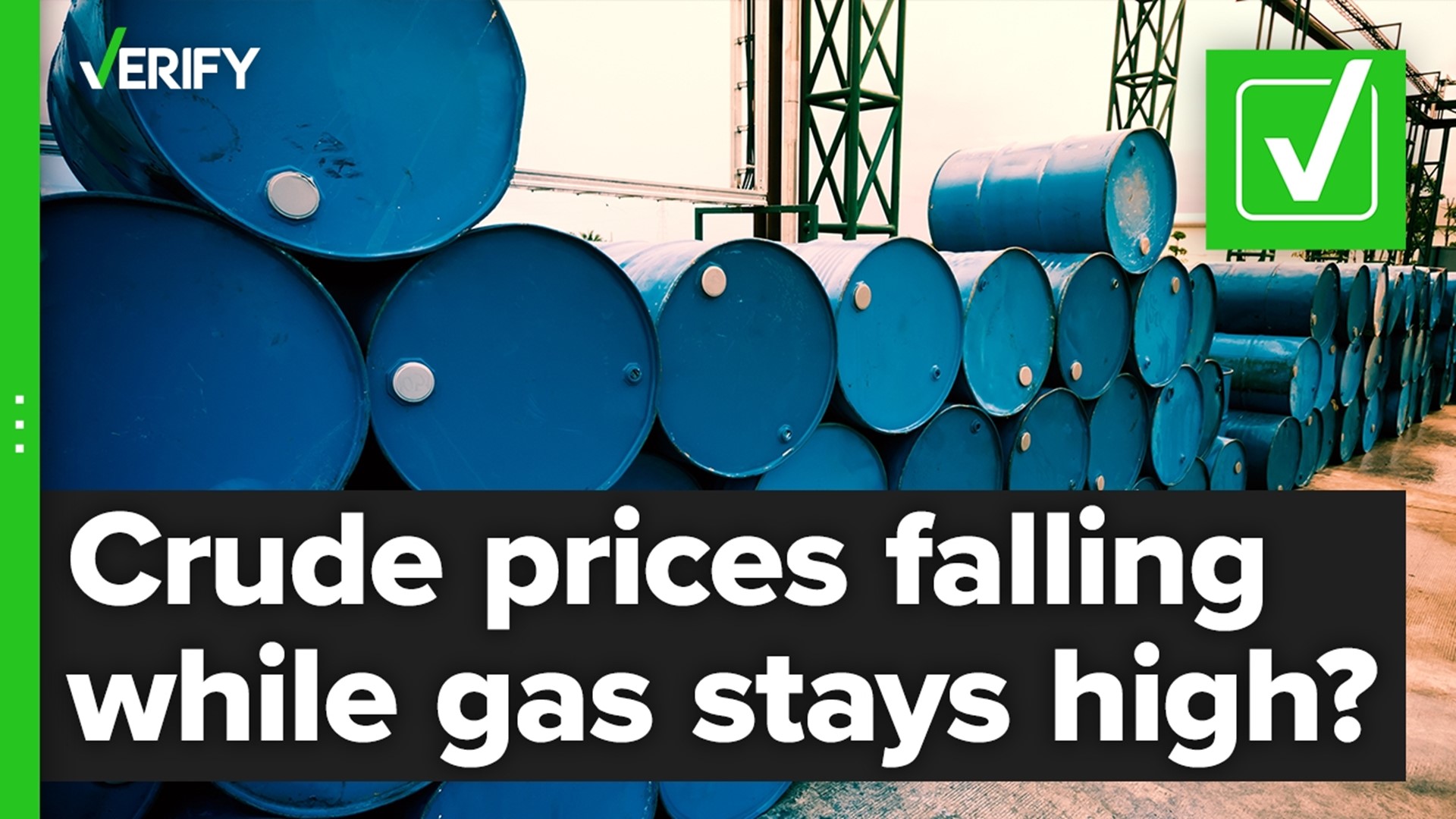The price of gas is still at or near record highs, and the reasons for that remain the subject of intense international debate.
In early March, not long after Russia’s invasion of Ukraine, the average price of gas broke previous record highs. Crude oil prices also neared all-time highs, but did not break records.
On March 16, President Joe Biden posted a tweet suggesting that there’s now a disparity between oil prices and gas prices as a result of corporate greed.
“Oil prices are decreasing, gas prices should too,” the tweet read. “Last time oil was $96 a barrel, gas was $3.62 a gallon. Now it’s $4.31. Oil and gas companies shouldn’t pad their profits at the expense of hardworking Americans.”
THE QUESTION
Did the price of gas stay high, even after the price of crude oil dropped?
THE SOURCES
THE ANSWER
Yes, the price of gas stayed high even as crude oil prices dropped.
WHAT WE FOUND
Retail gasoline is derived from crude oil. Gas is usually priced by the gallon, and oil by the barrel. The price of crude is one of the most important factors affecting the price of gasoline.
There are many types of crude oil, all of which are priced differently. The most common metric used for the cost of American oil is WTI (West Texas Intermediate), and that’s the metric the president referenced in a graph attached to his tweet.
According to the statistics website Trading Economics, on March 16, the day President Biden posted his tweet, WTI prices had dropped below $96 a barrel. Meanwhile, AAA data showed the average retail price of a gallon of gas on March 16 cost $4.31.
This lines up with two numbers cited in Biden’s claim: that oil cost $96 a barrel and gas cost $4.31 at the time he posted the tweet. But what about his comparison to gas prices the last time oil hit $96 a barrel?
Per Trading Economics, the last time WTI cost $96 or less was February 28, 2022. A barrel sold for $95.72 that day, according to that data. Daily numbers from the U.S. Energy Information Administration (EIA) show a similar result: $96.13 for a barrel of WTI crude on February 28.
So what did gas cost consumers on that day?
The EIA reports weekly figures for gasoline prices. The week of February 28, the average price of a gallon of gas in the United States was $3.70. AAA provided daily tracking statistics to VERIFY. On February 28, the retail price for a gallon of unleaded gasoline was $3.61.
This means the data supports Biden’s claim that the last time crude oil cost roughly $96 a barrel, gas was cheaper than it is now, at around $3.60 a gallon.
However, that doesn’t mean gas prices will stay as high as they are right now, around $4.30 a gallon.
The technology company GasBuddy tracks and studies fuel prices, and a spokesperson explained gas prices often lag behind oil prices during times of high volatility.
“Often, gas prices go up much faster than they come down. This is because when oil prices increase rapidly, gas stations are not able to reflect that right away at the pump due to local competition. Gas stations often take losses when oil prices rise quickly, and need a little bit of time to recoup those losses when prices are lowered again,” said Nicole Peterson via email on Wednesday.
“There is no hard and fast rule for how long it takes gas prices to drop once oil prices decline,” she added. “However, in this instance, we're expecting most of the US to feel some sort of relief in the next few days, and for prices to potentially drop below the $4 mark on average in the next 3-5 weeks. That is, of course, dependent on oil prices staying where they are now.”
Nonetheless, Biden isn’t the only one accusing the oil and gas industry of taking advantage.
Some members of Congress have called for a public investigation into price gouging.
A letter to House and Senate leadership requesting that investigation, signed by 32 members, reads in part, “as American families work to make ends meet, Congress must take action to investigate reports of illegal profiteering, anticompetitive business practices, and price gouging within the oil and gas industry and hold public hearings, as appropriate.”
The American Petroleum Institute, a trade association that represents many oil companies, responded to such accusations in an email.
“Across the economy, retail prices in many industries go down slower than they go up – this isn't a new phenomenon,” said Frank Macchiarola, API’s Senior Vice President of Policy, Economics and Regulatory Affairs. “As we've seen in the past, it takes time for changing market conditions to work through the supply chain and for the price of crude oil to be widely reflected in the price we pay at local gas stations, more than 95 percent of which are independently owned small businesses and not operated by oil companies.”

